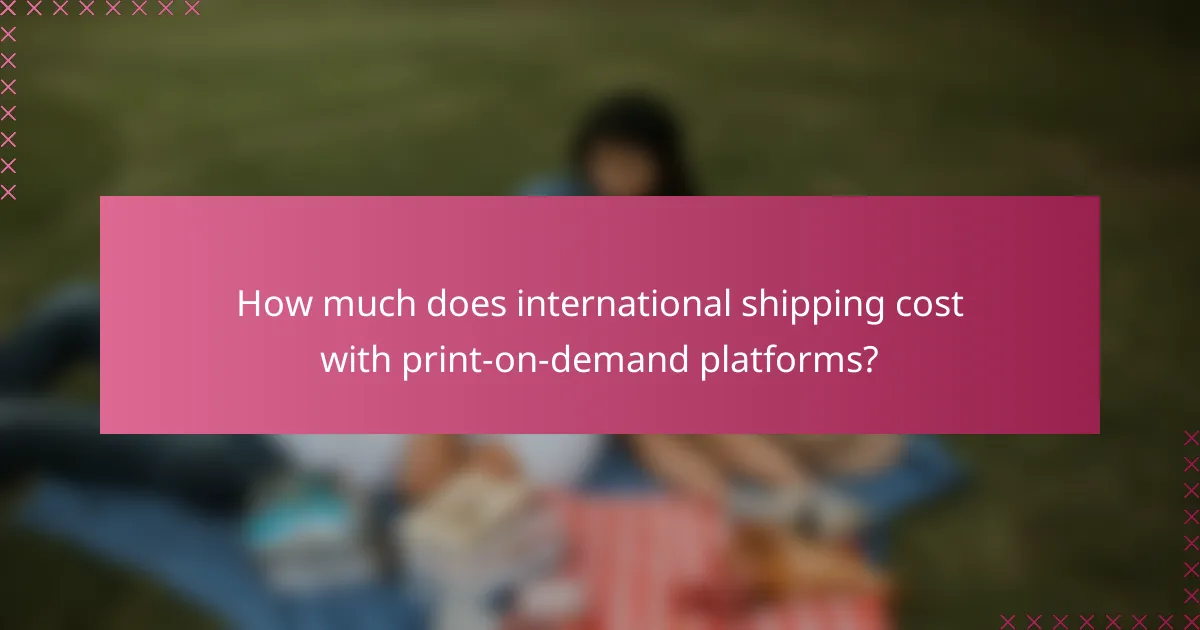When exploring print-on-demand platforms for international shipping, options like Printful, Teespring, Redbubble, Gooten, and SPOD stand out for their diverse features and cost structures. Shipping costs can fluctuate based on the provider, destination, and product type, typically ranging from low single-digit to mid double-digit amounts in USD. Additionally, businesses can select from various shipping options, including standard, express, economy, and regional carriers, each offering distinct benefits and trade-offs.

What are the best print-on-demand platforms for international shipping?
The best print-on-demand platforms for international shipping include Printful, Teespring, Redbubble, Gooten, and SPOD. Each platform offers unique features, shipping options, and cost structures that cater to different needs and markets.
Printful
Printful is known for its extensive range of products and global fulfillment centers, which help reduce shipping times. It offers international shipping to over 200 countries, with costs varying based on destination and product type.
Consider using Printful if you want a seamless integration with e-commerce platforms like Shopify or Etsy. Their pricing is transparent, but be mindful of additional costs for shipping and customs duties that may apply in certain regions.
Teespring
Teespring, now known as Spring, focuses on custom apparel and merchandise, providing international shipping options. They handle production and shipping, allowing creators to focus on marketing their products.
Shipping costs are generally reasonable, but they can vary significantly based on the destination. It’s advisable to check the shipping calculator on their site for accurate estimates before launching a campaign.
Redbubble
Redbubble offers a wide variety of products, from clothing to home decor, with international shipping available to many countries. They set shipping costs based on product dimensions and destination, which can lead to variable pricing.
Keep in mind that Redbubble includes production and shipping fees in the final price, which can affect your profit margins. Always review their pricing guidelines to ensure your products remain competitively priced.
Gooten
Gooten provides a robust platform for print-on-demand services with a focus on custom products. They offer international shipping, and their network of partners helps streamline the fulfillment process.
Shipping costs can be competitive, but they depend on the product and destination. Gooten allows you to set your own shipping rates, which can help you manage costs effectively for international customers.
SPOD
SPOD (Spreadshirt Print-On-Demand) is recognized for its fast production times and international shipping capabilities. They promise shipping within 48 hours for most products, making them a great choice for urgent orders.
While SPOD’s base prices are generally low, shipping costs can vary based on the destination. It’s beneficial to offer free shipping over a certain order amount to encourage larger purchases from international customers.

How much does international shipping cost with print-on-demand platforms?
International shipping costs with print-on-demand platforms vary based on the provider, destination, and product type. Generally, you can expect shipping fees to range from low single-digit to mid double-digit amounts in USD, depending on these factors.
Printful shipping rates
Printful offers international shipping rates that depend on the destination and the product’s weight. For example, shipping to Europe can start around $5 to $10 USD for smaller items, while larger products may incur higher fees. It’s advisable to use their shipping calculator for precise estimates based on your specific order.
Printful also provides options for expedited shipping, which can significantly increase costs but reduce delivery times. Always consider the balance between speed and expense when choosing your shipping method.
Teespring shipping costs
Teespring’s international shipping costs are generally competitive, starting at approximately $8 to $15 USD for standard delivery. The exact fee varies by country and product size, so checking their site for specific rates is recommended.
Teespring often includes shipping in the product price, which can simplify the purchasing process for customers. However, be aware that this may affect your profit margins, so factor in shipping when setting product prices.
Redbubble international fees
Redbubble’s international shipping fees typically range from $5 to $20 USD, depending on the destination and item type. They also have a flat shipping rate for certain products, which can be beneficial for bulk orders.
Keep in mind that Redbubble may charge additional customs fees or taxes depending on the destination country, which can impact the total cost for customers. It’s wise to inform buyers about potential extra charges to avoid surprises.
Gooten pricing structure
Gooten’s international shipping costs vary based on the product and destination, usually falling between $7 and $15 USD. They provide a shipping calculator to help you estimate costs before finalizing orders.
Gooten also allows for different shipping options, including standard and express, which can affect delivery times and costs. Evaluate the needs of your customers to choose the best shipping method for your products.
SPOD shipping expenses
SPOD offers international shipping rates that typically range from $5 to $12 USD, depending on the product and shipping destination. They are known for their fast processing times, which can enhance customer satisfaction.
SPOD also provides a shipping estimator tool, allowing you to calculate costs based on specific orders. This feature can help you set accurate pricing and manage customer expectations regarding delivery times and expenses.

What international shipping options are available?
International shipping options vary widely, catering to different delivery speeds and costs. Businesses can choose from standard, express, economy, and regional carriers, each with unique benefits and trade-offs.
Standard shipping
Standard shipping is the most common option for international deliveries, typically taking several days to a few weeks, depending on the destination. This method is cost-effective, making it suitable for businesses looking to minimize expenses while still reaching customers globally.
When using standard shipping, it’s essential to consider factors like tracking availability and customs clearance times. Many providers offer basic tracking, but it may not be as detailed as express options.
Express shipping
Express shipping provides faster delivery, often within 1 to 5 business days, making it ideal for time-sensitive orders. While this option is more expensive than standard shipping, it offers benefits like detailed tracking and guaranteed delivery dates.
Businesses should weigh the urgency of their shipments against the higher costs. For example, if a customer needs a product quickly, the investment in express shipping can enhance satisfaction and loyalty.
Economy shipping
Economy shipping is a budget-friendly option that typically takes longer than standard shipping, often ranging from 2 to 6 weeks. This method is suitable for non-urgent shipments and can significantly reduce shipping costs.
It’s crucial to inform customers about potential delays with economy shipping. Clear communication can help manage expectations and improve the overall customer experience.
Regional carriers
Regional carriers specialize in specific areas and can offer competitive rates and delivery times for certain regions. They may provide unique advantages, such as local expertise and tailored services that larger carriers might not offer.
When considering regional carriers, evaluate their coverage and reliability. They can be particularly beneficial for businesses targeting specific markets, allowing for more personalized service and potentially lower shipping costs.

What factors influence shipping times for print-on-demand products?
Shipping times for print-on-demand products are influenced by several key factors, including production time, the destination of the shipment, and the chosen shipping method. Understanding these elements can help you better estimate delivery timelines for your customers.
Production time
Production time refers to the duration it takes to create the print-on-demand product after an order is placed. This can vary significantly based on the complexity of the item and the print provider’s workload, typically ranging from a few days to over a week. For instance, custom apparel may take 3-7 days, while more intricate items like home decor could take longer.
To minimize delays, choose a provider with efficient production processes and clear timelines. Always communicate expected production times to customers to manage their expectations effectively.
Destination location
The destination location plays a crucial role in determining shipping times. Orders shipped domestically generally arrive faster than international shipments, which can take anywhere from a week to several weeks depending on customs processing and local postal services. For example, shipments within the EU may take 3-5 days, while those to countries outside the EU could take 10-20 days or more.
When targeting international customers, consider using fulfillment centers located closer to your target markets to reduce shipping times and costs. This strategy can enhance customer satisfaction and repeat business.
Shipping method
The shipping method selected can greatly impact delivery speed. Standard shipping is often the most economical but may take longer, while expedited options like express or overnight shipping can significantly reduce transit times, often to just 1-3 days. However, these faster methods typically incur higher costs.
When offering shipping options, provide clear choices for your customers, including estimated delivery times and costs. Encourage them to select expedited shipping for urgent orders, but also highlight the benefits of standard shipping for budget-conscious buyers.

How to select the right print-on-demand platform for your needs?
Choosing the right print-on-demand platform involves assessing your specific requirements, including shipping capabilities, product quality, and pricing. Focus on platforms that align with your target market and offer reliable services that meet your business goals.
Evaluate shipping options
When evaluating shipping options, consider the geographical reach of the platform and the shipping costs involved. Look for platforms that provide international shipping if you plan to sell globally, as well as various shipping methods to accommodate different customer preferences.
Compare the estimated delivery times for each shipping option. Some platforms may offer expedited shipping for an additional fee, while others might have standard shipping that takes longer but is more economical. Always check for any hidden fees that could affect your overall costs.
Compare product quality
Product quality is crucial in print-on-demand services, as it directly impacts customer satisfaction and brand reputation. Review samples from different platforms to assess the print quality, material durability, and overall finish of the products.
Look for user reviews and testimonials to gauge the experiences of other sellers. Pay attention to any recurring issues related to product quality, as these can indicate potential pitfalls. Additionally, consider platforms that offer a satisfaction guarantee or easy return policies to mitigate risks associated with product quality.
